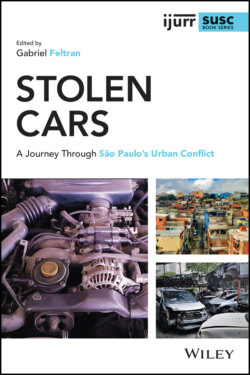Читать книгу Stolen Cars - Группа авторов - Страница 16
Notes
Оглавление1 1. Throughout the book we will use MW to represent Monthly Minimum Wage. All prices were adjusted to the minimum wage considering USD 1.00 = BRL 4.00 (2010 average) and the national monthly minimum wage of BRL 1,000.00 (or USD 250.00) in 2020 values. It is important to remember that the real value of the Brazilian minimum wage increased by 75 percent between 2004 and 2019 (G1 2019 [https://g1.globo.com/economia/noticia/2019/04/15/veja-historico-dos-ultimos-reajustes-do-salario-minimo.ghtml]).
2 2. An individual subway or bus ticket costs 0.004 MW. There are no weekly or monthly plans that might reduce the cost, although Bilhete Único tickets, which allow free train-subway-bus transfers within a single journey, are available. In 2018, 6 out of 10 Brazilian workers earned the minimum monthly wage (Agência O Globo 2019).
3 3. The democratization of automobiles in the city during the past 20 years has occurred thanks to the dynamism of the informal used cars and auto-parts market and, more importantly, the expansion of credit to lower-income earners during the Lula governments (2002–2010). This phenomenon has, as a direct side effect, or even as a foundational element, led to a related increase in vehicle thefts and vehicle theft rings.
4 4. O Globo 2017. https://oglobo.globo.com/economia/no-mundo-1-mais-rico-detem-20-da-renda-brasil-ainda-mais-desigual-22190904.
5 5. All narrated scenes, character profiles, and transcribed documents are faithful to data obtained during our field research. All the characters have been given fictitious names; all newspaper reports have been slightly modified and parts of the dates and names of territories and cities have been changed to protect interlocutors in the field, be they thieves, police officers, civil servants, businessmen, or their families. The methodology section details the ways in which the writing of an ethnography based on five cars’ journeys was constructed.
6 6. Loïc Wacquant’s (Wacquant 1996, 2009; Wacquant and Howe 2008) highly relevant studies on advanced marginality and the penal state are examples of this normative approach and very influential within this literature.
7 7. Police Ombudsman of the State of São Paulo (2018), available at http://ftp.sp.gov.br/ftpouvidoria-policia/Anual2018.pdf.
8 8. The sociology of public action and the idea of governance as stated by Lascoumes and Le Galès (2012) helps us to think about how these markets are regulated in everyday situations.
9 9. Beckert and Dewey (2017), Dewey (2015, 2016), Feltran (2014), Guyer (2004), Hirata (2018), Rabossi (2011, 2015), Telles (2010).
10 10. Everyday life, the dispositions of actors, and resources constructing the “unequal city” are the core conceptual framework used by Blokland (Blokland et al. 2016; Blokland 2017), with whom I have worked and from whom I learned a great deal in the past few years. Misse (Misse 2010) and Machado da Silva (Machado da Silva 2016) follow an identical path. A deeply controversial “sociology of money” also exists, dating back to Simmel (2004) and including authors such as Hart (1973), Neiburg (2007), Wilkis (2017), and Zelizer (1978, 1988, 1994, 2011).
11 11. One line of ethnographic studies on the world of crime in Brazil has been built in opposition to the normative and legal notion of organized crime (Biondi 2018; Feltran 2016; Hirata 2018; Telles 2010b). To emphasize this as a controversial expression, we have chosen to use quotation marks.
12 12. Although Georg Simmel does not appear among the fundamental references of the authors, the approach proposed by them can be directly related to Simmel’s theories (Simmel 2010) as well as to the results of this production both in the classic by Goffman (2016) and later in Cefaï and Gardella (2011).
13 13. Resolution 510 of the National Health Council on Research Ethics in Human Sciences, of April 7, 2016. http://conselho.saude.gov.br/resolucoes/2016/Reso510.pdf.
